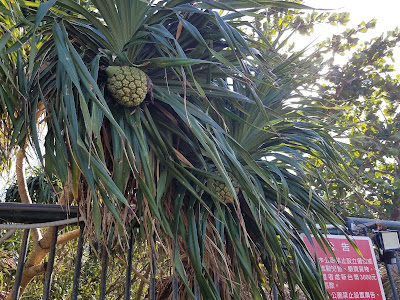 |
| The large grass, Miscanthus sinensis, dominates much of the open land in Taiwan, with spectacular bloom spikes in December. |
 |
| In the spectacular Taroko Gorge, a species of Hibiscus greets December visitors. |
 |
| A close-up of the Hibscus from Taroko, which may be either H. taiwaniensis or H. mutabilis. |
With the introduction of Chinese civilization to Taiwan came more trade and active interest in horticulture, and likely more "non-native" plants. Be that as it may, these are some of the wild plants that I found blooming in Taiwan during the month of December.
Our three weeks in Taiwan took us to Taroko Gorge, Alishan, and Sun Moon Lake in the central mountains, as well as tropical Kenting National Park in the south, and Yangmingshan National Park in the North.
 |
| A species of Pandanus from the southern end of Taiwan. |
 |
| Ipomoea pes-caprae grows along Taiwan's beaches as it does in Florida and tropical beaches around the world. |
 |
| Phoenix hanceana is the native member of the date palm genus in Taiwan. Here it is growing along the wind-swept coastal bluffs in Kenting National Park. |
 |
| Evolvulus alsinoides is another member of the morning glory family, Convolvulaceae. |
 | ||
|
 |
| Another late-blooming yellow Asteraceae from the mountains |
 |
| Tithonia diversifolia blooms abundantly on mountain slopes west of Alishan. |
 |
| A morning glory, Ipomoea cheirophylla, is common along roadsides throughout Taiwan. |
 |
| A wild begonia blooms in the Yangmingshan National Park near Taipei. |
 |
| A yellow member of the mint family, Salvia nipponica, continues to bloom in Yangmingshan at about 2500 ft elevation, despite chilly December temperatures. |
No comments:
Post a Comment
Note: Only a member of this blog may post a comment.